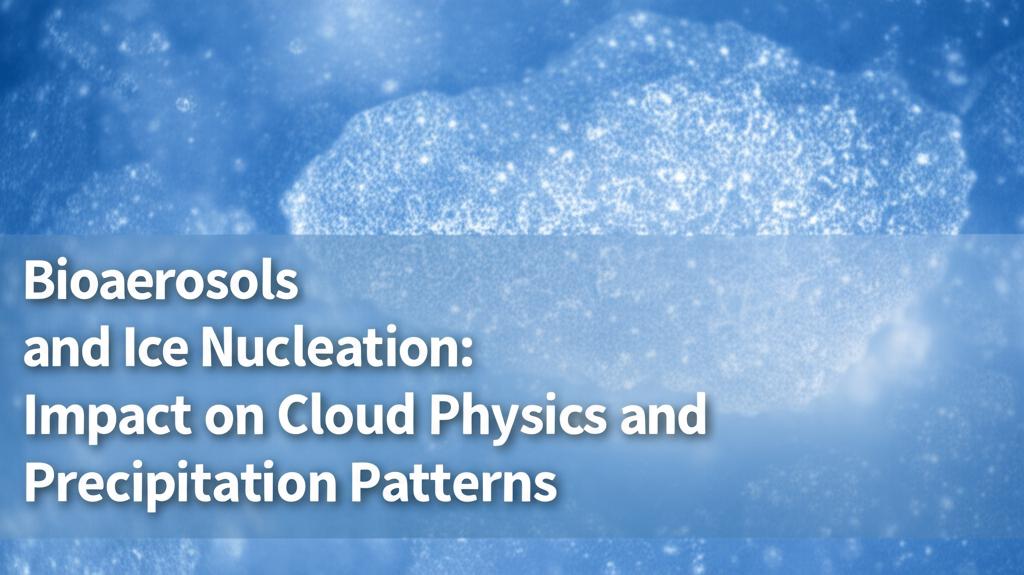Floating unseen in the air we breathe, tiny biological particles known as bioaerosols play a surprisingly significant role in shaping our weather and climate. These microscopic particles, originating from living organisms, include bacteria, fungal spores, pollen, viruses, and fragments of plants and cells released from both land and oceans. While often studied for their impact on air quality and health, their influence extends high into the atmosphere, directly affecting how clouds form and behave.
Bioaerosols are naturally released into the atmosphere from sources like soil, vegetation, oceans (via sea spray), and even freshwater bodies. Wind turbulence lifts these particles from surfaces, allowing them to be transported locally or even across continents by weather systems and dust plumes.
One of the most critical atmospheric functions of bioaerosols is their ability to act as ice nucleating particles (INPs). Cloud droplets need a surface to freeze upon, especially at temperatures warmer than -38°C (-36°F), where spontaneous freezing occurs. While mineral dust is a common INP, certain bioaerosols possess a unique advantage: they can initiate ice crystal formation at significantly warmer temperatures, sometimes as high as -5°C to -15°C (23°F to 5°F). This exceptional ability is often attributed to specific proteins or unique structural features on their surfaces.
This capacity to trigger ice formation at relatively mild subzero temperatures has profound implications for cloud physics. Clouds containing both supercooled liquid water droplets and ice crystals are known as mixed-phase clouds. The presence of bio-INPs can accelerate the transition from liquid droplets to ice crystals within these clouds. This process, known as glaciation, alters the cloud's composition, lifetime, and how it interacts with sunlight and heat radiation from the Earth. By influencing whether a cloud is primarily liquid or ice, bioaerosols can impact the cloud's reflectivity (albedo) and its overall warming or cooling effect on the climate.
The formation of ice crystals is a crucial step in the development of precipitation in many clouds. Ice crystals grow much faster than liquid droplets by collecting water vapor, eventually becoming heavy enough to fall as snow or, if they melt on the way down, rain. By facilitating ice formation, bioaerosols can influence the efficiency, timing, and type of precipitation a cloud produces. Intriguingly, rainfall itself can trigger the release of more bioaerosols from soil and plants, creating a potential feedback loop sometimes referred to as the "bioprecipitation cycle," where biological particles influence rain, and rain, in turn, releases more biological particles.
The impact of bioaerosols is particularly notable in certain regions. In remote areas like the Arctic or over vast oceans, where other types of aerosol particles may be scarce, bioaerosols can be dominant players in ice nucleation. Recent research in the Arctic, for example, highlights a strong connection between regionally sourced biological particles and the formation of ice crystals at unusually high temperatures (up to -15°C). As the Arctic warms, changes like reduced sea ice and increased vegetation cover are expected to alter the types and amounts of bioaerosols released, potentially creating significant feedback effects on the rapidly changing Arctic climate. Similarly, studies in the Amazon rainforest are working to quantify the ice-nucleating activity of different bioaerosol groups like fungal spores and bacteria.
Despite growing recognition of their importance, accurately quantifying the overall contribution of bioaerosols to cloud formation and precipitation remains a significant challenge. Their concentrations vary greatly depending on location, season, and weather conditions. Furthermore, their interaction with clouds is complex; some recent studies suggest that while potent ice nucleators, some bioaerosols might be relatively poor at initially attracting water vapor to form cloud droplets (acting as Cloud Condensation Nuclei or CCN), which could potentially limit their ice-forming opportunities in certain conditions. Incorporating these intricate processes accurately into climate models is an ongoing area of research, crucial for reducing uncertainty in future climate projections.
In conclusion, bioaerosols are far more than just airborne microbes or pollen. They are active participants in atmospheric processes, acting as highly effective ice nucleators that influence the fundamental properties of clouds and the patterns of precipitation worldwide. Understanding their sources, transport, and interactions within clouds is essential for a complete picture of weather systems and for predicting how our climate may continue to evolve.

